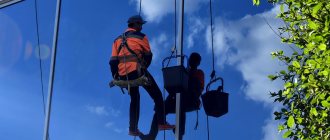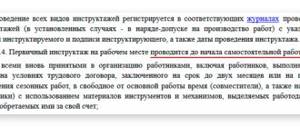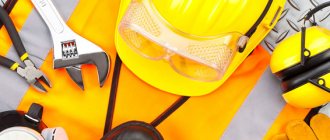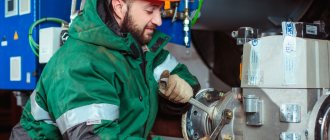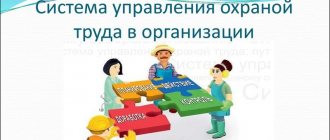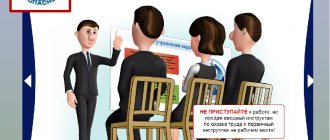Home / Labor Law / Personnel Management / Personnel training and certification
Back
Published: 08/09/2016
Reading time: 7 min
0
755
The Constitution gives citizens of the Russian Federation not just the right to get a job, but also the opportunity to carry out work in decent conditions that meet all basic safety and sanitary requirements.
Ensuring such conditions is one of the main responsibilities of any employer imposed on it by labor legislation.
In order to verify the compliance of the workplaces equipped by the employer with the basic requirements, the state conducts regular certification of all persons engaged in commercial and production activities, with the exception of individuals who have organized private business activities and are individuals.
- Legislation
- Goals and criteria for certification
- Requirements for inspectors
- Order of conduct
- How are the results presented?
- What should the employer do after receiving the results?
Last changes
It is everyone’s right to carry out their work activities in safe conditions. Russian reality makes adjustments to this axiom.
According to the law, an employer who has people under his command, no matter how many, is obliged to protect them from the negative factors inherent in the workplace. At least 0.2% of the money spent by a given organization on the production of goods must be invested in labor protection. The amount in reality turns out to be insignificant, but even this is not always spent. Often people do not receive basic protective equipment, not to mention compensation for working in difficult conditions.
Certification of workplaces was aimed at identifying dangerous, harmful production conditions and adjusting existing factors to the standards established by the state.
But, as life has shown, the certification was carried out for show and did not have serious, far-reaching intentions of the management to improve the working life of the staff. In many ways, this happened because there was no special legislative act, and the punishments were not particularly impressive.
The end of fictitious workplace certification was marked by the adoption of the law “On Special Assessment of Working Conditions” in 2013. It redefines the appraisal campaign.
SOUT is a set of measures that help recognize unfavorable conditions and assess their impact on workers.
In general, the essence of a special assessment does not differ from the essence of certification. The key differences are the detailed regulation of the procedure for its implementation and more severe penalties for failure to carry out or delay.
The results of the SOUT are used for rather bland but necessary purposes, such as prevention or control. But, in addition, the results can provide benefits to employees, such as an increased rate of contributions to the Pension Fund, guarantees and compensation.
Therefore, the team is more than interested in conducting a proper assessment. And the law allows employees to inquire about the progress of the inspection, ask questions and appeal its results. And union representatives can even initiate an unscheduled assessment. But first things first.
The difference between SOUT and certification
After 2014 - SOUT.
Until 2014, certification cards were issued for all workplaces, without exception, but after this period, some changes were made to the regulatory framework and they are not accidental.
Differences between certification and special assessment of UT:
- expert organizations carry out instrumental measurements at all workplaces, without exception;
- Based on the data obtained, laboratory tests are carried out, if necessary;
- If maximum permissible concentrations and levels of harmful components and substances hazardous to health are detected, workplaces are included in a separate list. If no harmful factors are identified, then a declaration of compliance with the occupational safety requirements of these workplaces is filled out; if, on the contrary, an excess of harmful components in the air environment of the work area is detected, then further work is carried out to justify benefits, compensation payments and determine labor classes. In other words, a SOUT map is drawn up.
When conducting an assessment, documents are not drawn up for all places of work, but only for those where there are dangerous or harmful factors.
Goals
Certification of workplaces was aimed at maintaining the health of workers, preventing accidents and occupational diseases, identifying the usefulness or uselessness of protective equipment, and motivating management to improve the working environment.
SOUT has similar goals, and additional ones have appeared:
- Unification of the procedure. Previously, there were as many as 3 verification procedures: certification of workplaces and state examination of working conditions, regulated by the Labor Code, SOUT, provided for by the Federal Law “On Insurance Contributions”. The legislator noted: it is necessary to combine these procedures. Then the businessman will have to bother only once, and the results of the check will be used to the widest extent.
- Determination of hazard classes. When a person works in unfavorable conditions, by law he is entitled to certain compensation, such as a shortened working week or additional leave. Harmfulness/danger can be identified precisely based on the results of the assessment assessment. So, without a special rating, you shouldn’t count on a can of condensed milk.
- Calculation of the additional tariff for contributions to the Pension Fund. This tariff is provided for persons applying for preferential retirement.
- Resolution of labor conflicts. If an employee complains to the inspectorate or to the court about poor conditions, only the documents on SOUT will justify management.
Who is exempt from assessment
Certification has long provoked controversy: is it necessary or not to check office plankton sites? The new Federal Law put an end to the dispute. We need to check. A special assessment of working conditions is an inevitable event for all entrepreneurs without exception. Even if employees are sitting in a clean, comfortable office and pressing keys on a laptop, this does not exempt their management from checking.
The jobs of people working are exempt from SOUT:
- remotely;
- at home;
- for individuals who do not have individual entrepreneur status.
Conducting an assessment
What I thank the new Federal Law for is the meticulous schedule of the procedure. The SOUT order is as follows.
- Formation of the commission. The commission is created from an odd number of people. It is imperative to include a labor protection specialist. If there is a trade union, its representative also becomes a member of the commission. As with the former certification of workplaces, a schedule is discussed.
- Establishing a list of evaluated jobs. When places are similar, not all are checked, but 20% of the total (but not less than 2). By similar places we mean those with the same level of noise, lighting, and ventilation systems, where workers perform the same duties, using the same type of equipment and protective devices.
- Agreement with the company. The Ministry of Labor took care of entrepreneurs in order to avoid cooperation with deceiving organizations and indicated on its website a list of approved companies. It is necessary to conclude a civil contract with her. When certifying workplaces, it was possible to involve not one, but several organizations. And now such a possibility is not excluded. Expert appraisers are not members of the commission; they act independently.
- Transfer of necessary documents to experts. These are the Charter, job descriptions, tax identification number, staffing table, etc. There is no need to withhold any documents or information about the specifics of the company’s activities. Appraisers are like doctors: they tell only the truth for their own benefit.
- SOUT according to the methodology approved by the Ministry of Labor. A distinctive stage of the special assessment procedure compared to workplace certification is identification. Harmfulness or danger has been identified - it is necessary to conduct research to identify its degree and assign a class or subclass. If, based on the results of the special assessment and assessment, absolutely no unfavorable factors are identified, the director submits a declaration of conformity to the inspectorate. It is valid for 5 years. During these 5 years, no injuries, self-harm, other misfortunes or occupational diseases occurred in the company - viability is extended for another 5 years. Identification is not carried out in certain cases, for example, if a previous assessment has already identified harmfulness. We need to move straight to research.
- Reporting. You are given 3 days to send a copy of the report to the appraiser.
- Results of SOUT to the people. After approval of the report, the employer is obliged to demonstrate it to the workforce against signature. According to previously existing legislation, the conclusions of workplace certification were communicated to workers within 10 days, now the period is 1 month.
- Posting information about the results of the inspection on the website (if there is one). This is a new requirement; it did not exist at the time of workplace certification.
- Form 4-FSS. A report on this form must certainly be sent to the insurance fund.
- From words to deeds. Next comes the most difficult thing: using the results of the special assessment in practice. First, certain employees' employment contracts must be amended or supplemented to include hardship bonuses. Secondly, contributions to the Pension Fund are calculated according to new tariffs, depending on the hazard class. Previously it was 6% or 9%, but now it’s from 2 to 8% if the conditions are harmful or dangerous. Increased tariffs are applied precisely based on the results of the SOUT. That’s why pensioners, when they tearfully, when they menacingly ask to submit the results of the special assessment on time.
The special assessment procedure - how jobs are certified in stages
Workplace certification (JWC) is carried out by an independent specialized organization, which the employer invites to identify factors that deviate from the norm. It is necessary to conclude a civil contract with such a company (Article 8 of Law No. 426-FZ).
The result of the inspection is drawn up in the form of a report, which is approved by Order of the Ministry of Labor of Russia dated January 24, 2014 N 33n. The employer begins to apply the results of the inspection from the date of approval of the report: when identifying the need to provide employees with the required guarantees and compensation, provide protective equipment, provide milk and improve the situation. If the commission recognizes the working conditions as safe, then the employer remains to monitor and maintain everything at the proper level.
However, the first step will be preparation for workplace certification (special assessment), which occurs even before inviting a third-party organization for inspection. At the first stage, the employer:
- forms a commission for carrying out the special assessment and assessment process, which should include representatives of the employer, trade union and human resources specialist. The commission is headed by the employer or his authorized representative. The number of commission members is odd. The formation of the commission must be formalized by order;
- approves the certification schedule in any form and familiarizes the commission with it;
- draws up a list of workplaces at which the assessment will be carried out;
- and after that enters into an agreement with a specialized organization for verification.
The second step is to directly assess the operating conditions. When checking, an expert from a third-party company:
- identifies potentially harmful and dangerous factors. The employer provides the expert with all the necessary information, documents and oral explanations, otherwise the organization has the right to suspend or not begin the inspection. Based on the results of identifying harmful factors, a protocol is drawn up;
- measures and investigates harmful and dangerous factors if they are identified. After which a protocol on the results of measurements and tests is also drawn up and approved.
The final stage of certification is a summing up of the results of the test. The employer:
- approves the report compiled by the expert organization. All members of the commission created before the start of certification leave their signatures on the report. The organization that conducted the inspection must be notified of the approval within 3 business days;
- submits a declaration to the labor inspectorate on the compliance of working conditions with state regulatory requirements no later than 30 working days from the date of approval of the special assessment report. The declaration form and submission procedure are approved by Order of the Ministry of Labor of Russia dated 02/07/2014 N 80n;
- informs employees against signature of the results within 30 days from the date of approval of the report. Before the introduction of SOUT, to familiarize the employee with the conditions of his work, a workplace certification card was used, on which he put his signature. Now it has been replaced by a card for a special assessment of working conditions, the form of which was approved by Order of the Ministry of Labor of Russia dated January 24, 2014 N 33n;
- publishes on its official website (subject to its availability) final summary data on the results of certification within 30 days;
- when submitting the next report to social insurance in Form 4-FSS, it is mandatory to reflect information about the results of the special assessment in Table No. 5.
Deadlines
A planned assessment, like the previous certification of workplaces, should be carried out once every 5 years. When you have approved the SOUT report, start counting down.
The legislator has provided time for the transition and getting used to the new rules. If workplace certification was carried out before the end of 2013, a special assessment could not be carried out for a further 5 years.
But the deadline expired in December last year. So an assessment will have to be carried out in 2021. Honestly, it should have been done back in 2018. Labor inspectors may well show an unhealthy interest in delaying deadlines.
In addition to the planned one, there is an unscheduled SOUT. The list of reasons for its implementation has been slightly modified in comparison with the reasons for unscheduled certification of workplaces.
An unscheduled assessment is inevitable if:
- new jobs are beginning to be exploited;
- Based on the results of state supervision, violations of the Federal Law “On SOUT” were discovered, and the entrepreneur received an order to conduct an unscheduled special assessment;
- there was an injury, mutilation or occupational disease, they arose due to the influence of the work environment;
- other reasons.
An unscheduled emergency assessment must be carried out within 6 months after the occurrence of such situations (sometimes within 12 months).
Certification of workplaces and payment of insurance premiums in 2021
Workers in harmful and hazardous industries have the right to count on early retirement, so employers pay insurance premiums for them at increased rates (Article 30 of Federal Law No. 400-FZ of December 28, 2013). Therefore, the amount of insurance premiums directly depends on the results of workplace certification (special assessment).
Additional tariffs are established in Article 428 of the Tax Code of the Russian Federation. For employers who pay insurance premiums based on the results of a special assessment of working conditions, they are lower.
If a workplace certification (SOUT) was not carried out, then the tariffs will be 9% or 6% depending on the harmfulness of production factors.
The assessment will allow us to divide working conditions into classes and subclasses and differentiate tariffs. Article 14 of Federal Law N 426-FZ distinguishes 4 classes:
- dangerous;
- harmful;
- acceptable;
- optimal.
According to Art. 428 of the Tax Code of the Russian Federation, permissible and optimal classes do not require the payment of additional contributions - the additional tariff for them is 0%. Employers who have carried out certification and established that the working conditions of individual employees are considered hazardous, pay insurance premiums for these employees at a rate of 8%, and hazardous conditions are divided into subclasses and the rates for them range from 2% to 7%.
Responsibility
The highlight of the program is Article 5.27.1 of the Administrative Code. It is she who establishes punishment for not caring about people.
The article states that failure to conduct a special assessment or failure to comply with the procedure is punishable by a fine:
- officials – 5 – 10 thousand;
- legal entities - 60 - 80 thousand;
- entrepreneurs - 5 - 10 thousand rubles.
Previous fines for workplace certification were significantly less. Entrepreneurs risked one thousand - five thousand, and legal entities - thirty - fifty thousand.
Willful employers who repeatedly violate the law are punished as follows:
- officials - a fine of 30 - 40 thousand rubles, or suspension from 1 to 3 years;
- entrepreneurs – a fine of 30–40 thousand, or suspension of work for up to 3 months;
- legal entity - a fine of 100 - 200 thousand or suspension of work for up to 3 months.
Article 5.27.1. The Code of Administrative Offenses provides for a warning as a punishment. The Ministry of Labor focused on the fact that this measure will be a priority for small businesses. Employers may be sent a warning indicating a time frame for correcting violations.
Since 2021, data on SOUT is stored in FSIS, the federal state information system. Experts warn that automatic fines are planned to be introduced in 2021. If the system does not have information about a special assessment from a specific company, a fine is calculated automatically. But the procedure for automatic collection of fines has not yet been approved.
Criminal liability for non-compliance with labor protection is provided for in Art. 143 of the Criminal Code. As before, when certifying workplaces, failure to carry out or negligently carried out the special assessment and assessment, resulting in damage to the health or life of an employee, can result in a fine, correctional labor, or prison.
If you look at practice, you can see that labor inspectors have already become more active. Data on fines imposed are published on the websites of regional labor inspectorates for the edification and intimidation of the irresponsible.
There are also active orders to appear and give explanations as to why the special assessment was not carried out within the established time frame.
Cost of workplace certification
The cost of workplace certification (JWC) is determined not only by the price of the contract that the employer enters into with a specialized company. Specialized organizations offer to assess working conditions at a price of 500 to 1000 rubles. for one place. In addition to the market price of the contract, the following may be added to the cost of a special assessment of working conditions:
- additional insurance contributions and allowances for employees when harmful factors are identified;
- costs for improving working conditions, modernizing equipment and replacing collective and individual protective equipment;
- large fines for the lack of certification results if the results of the audit are declared invalid.
Before concluding an agreement to conduct a special assessment with an outside organization, check whether it really has the right to conduct a special assessment. Certification of workplaces according to OKPD 2 has code 71.20.19.130. Information about this should be in the company’s documents, and the organization itself should be included in a special register, which is posted on the official website of the Ministry of Labor.
Legal documents
- Order of the Ministry of Labor of Russia dated February 20, 2014 N 103n
- Federal Law of December 28, 2013 N 426-FZ
- Art. 5.27.1 Code of Administrative Offenses
- Federal Law of December 28, 2013 N 400-FZ
- Article 428 of the Tax Code of the Russian Federation
- Federal Law N 426-FZ
- Art. 428 Tax Code of the Russian Federation
- Law N 426-FZ
- Order of the Ministry of Labor of Russia dated January 24, 2014 N 33n
- By Order of the Ministry of Labor of Russia dated 02/07/2014 N 80n
- Order of the Ministry of Labor of Russia dated January 24, 2014 N 33n
- Law N 426-FZ
Adviсe
You cannot renounce carrying out SOUT under any pretext, so remember a few tips that will make this process painless:
- Check the appraiser company. Request its charter documents: SOUT is indicated as a key area of activity - everything is fine and wonderful. Experts must be certified, and one of them must have a medical education of a certain specificity. Finally, the organization has a testing laboratory within its structure. Meeting these requirements means that the appraisal company is reliable and can be dealt with without fear. Taking into account the sad experience of workplace certification, when many scammers were operating, the Ministry of Labor put together a list of all organizations allowed to carry out the assessment.
- Don't skimp on appraisers. There are 3 categories of jobs: office, 1st and 2nd categories. It is clear that assessing the place of a lawyer working in hothouse conditions is not the same as assessing a metallurgist who has been thrown into the fire in the literal sense. Even the Ministry of Labor states that it costs 2,500 – 4,000 rubles to evaluate one workplace. And if we are talking about a place that requires measuring the level of chemicals, the price can jump three times. And this is justified. The price consists of the remuneration of experts, wear and tear of equipment, the cost of consumables, and the use of expensive evaluation instruments. Companies that offer suspiciously low prices may conduct an assessment in such a way that the first inspection will result in a fine for this filthy letter.
- For SOUT, as before for certification of workplaces, the employer pays. But the Social Insurance Fund can return part of the money given to appraisers in the form of a discount. To receive a discount for carrying out a special assessment, you need to submit to the insurance fund an application for a discount, a plan of occupational safety measures, a cash support plan, and all documents for a special assessment. The discount from the Social Insurance Fund on the insurance rate can reach 20%.
- Improved working conditions - order a new assessment, even if it’s not due yet. This will save on deductions and employee benefits.
